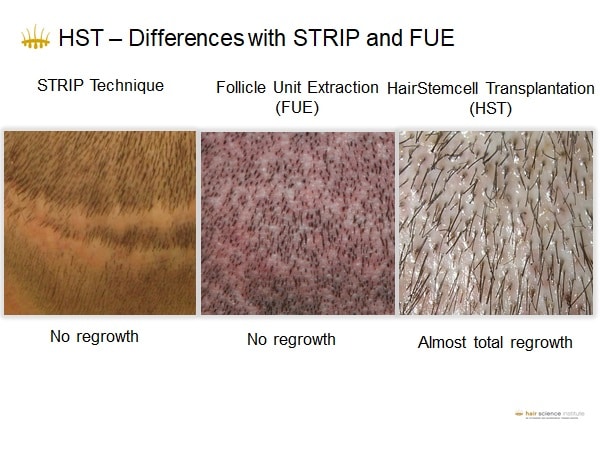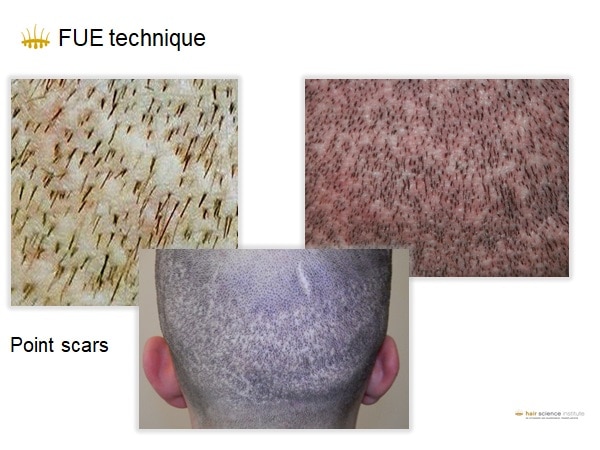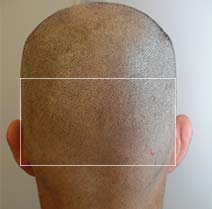HAIR TRANSPLANT WITHOUT SCARS AND WITHOUT BANDAGE


cicatrice da intervento FUT


directly after HST surgery
However transplantation with the HST technique does not create scars or require bandaging
There is another technique, the HST Hair Stemcell Transplantation, i.e. transplantation with multiplication or cloning of stem cells, which does not create scars on the patient’s head.
Review of the different techniques focusing on the post-operative aspects.
The post-operative course in transplantation techniques
Let us first consider the FUE. This technique, which has been an advance compared to what was previously done, consists in the complete extraction of follicular units by taking them from the patient’s donor area. To do this, punches are used, i.e. sampling tools that vary in diameter from 1 millimeter to 0.7 millimeters for the smallest (micro-FUE). Operating with these dimensions, a follicular unit is extracted completely. The donor area has a fixed quantity of follicular units available for transplantation, which can be called the « available capital ». The extractions are carried out with a certain distance from one to another follicular unit in order not to create too large and unsightly shortages. The minimum size is 0, 7 mm. Below that size, the graft is too thin and therefore without any possibility of survival.
The survival of grafts extracted with HST
With the HST technique grafts are taken instead with punches from 0.5 to 0.6 mm. These grafts survive thanks to a patented medium containing, among other components, extracellular matrix, exosomes, so that this medium is similar to what is used in the organ transplant.
With FUE and FUT transplants a bandage is required
The grafts taken with the FUE technique from the donor area generate a number of tiny scars. Meanwhile, the patient must be bandaged after surgery, because the small wounds are bleeding. Then any wound will heal. Since there are so many small scars, taken together they can create a fibrosis of the scalp.
It is also evident that this technique is limited by the number of follicular units available in the donor area. Therefore, if the surface to be reconstituted is large, a complete restoration cannot be realised, because at the most one donor area can make about 5000 follicular units available. Available statistics say that about 40 percent of patients are told that their donor area is insufficient to perform an acceptable transplant.
If we then examine the transplant performed with the FUT technique, this consists in the removal of a strip of scalp from the donor area. This strip is then subdivided at the level of each follicular unit. Each cutout of the scalp thus obtained, square-shaped, is then inserted into suitable round openings created by the surgeon in the recipient area.
The donor area is therefore subject to a reduction of considerable size. The edges of this wound must then be stitched up. The surgery is performed in an operating room. It is evident that this stitching creates a long scar which, even if well done, remains evident if the hair is cut short. The stitching of the two flaps after removing the strip of scalp creates a certain tension and also causes a slight change in the orientation of the hair.
The scars can be multiple if a person undergoes this type of surgery several times, which however allows the use of significant quantities of follicular units. Naturally, the donor area is reduced to the surface, given the subsequent removal of strips of the scalp. It is also clear that the post-operative course is more complicated and painful than that which occurs with FUE.
HST: multiplication of follicular units, no scars, no bandage
Intervening with the HST technique, Hair stemcell Transplantation :
As we have already said the extractions with this technique are made with very low size punches, 33 percent smaller than the smallest punch FUE. The very small wounds that are then created naturally heal in a very fast time, do not require bandaging, and do not create any fibrosis. Furthermore, by taking only a portion of the follicular unit, the portion that remains in place regenerates exactly and identically to the hair removed. This happens thanks to the action of the hair stem cells contained in the portion left in place. This phaenomenon allows the regeneration of the donor area, without shortages due to total withdrawals of follicular units and therefore without depriving the patient of precious follicular units from his available capital.
This procedure can then be repeated if important areas need to be restored, without pauperizing the donor area which instead reconstitutes itself every nine months. This is in fact the hair growth cycle. The grafts taken with this technique are extremely thin, practically without any tissue. The hair stem cells are really naked on these grafts : therefore they have to be handled with extreme caution so as not to cause damage that could prevent regrowth after transplantation. The subdivision of the hair stem cells then is done into two different sections : one that remains in the donor area and the other that goes to be transplanted in the recipient area. This phenomenon constitutes a huge advantage over traditional techniques which instead have a limited number of follicular units available. The HST technique has the advantage of not leaving scars or making the donor area impoverished, since for each partial removal of the follicular unit, there is regrowth . In summary: the FUE technique leaves small scars all over the donor area, it leaves small lacks where the follicular units have been removed. Its limit is the size of the area to be restored which, if large, will remain only partially restored. The FUT technique does not create holes in the donor area, but it decreases its surface. It leaves long scars which unfortunately remain visible. It allows you however to transplant more follicular units than FUE. Summarising, the HST technique has numerous advantages over other techniques : no scars, very mild post-operative course, no bandages. It regenerates the partially removed follicular units, while multipling the follicular units and allowing the restauration, in several successive phases, of very balding areas so vast that cannot be treated with other techniques.
